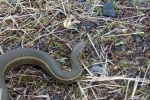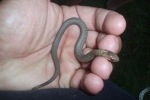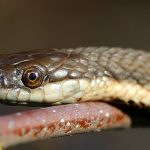Short-headed Gartersnake

Scientific Name: Thamnophis brachystoma
Size: 18 - 26 inches (46 - 66 cm)
Status: Species of special concern
Habitat:
Open country, dense woodlands, old fields, meadows, and wood/field borders. May be found under stones, rocks, logs, boards, and other debris, but is often seen out moving or basking.
Description:
A small to medium sized snake with a short head that is not distinct from the body. Side stripes are located on the 2nd and 3rd rows of scales from the belly that may be bordered by fine black lines. Unlike the eastern garter snake, the short-headed garter snake does not have black spots between the stripes. Scales are keeled and the anal plate single. Lives under debris in open areas near water where it feeds on amphibians and earthworms.
- The dorsal background is olive to olive brown.
- The dorsal has one vertebral and two lateral stripes.
- The vertebral stripe is bright beige to yellow that is distinct from the background.
- The lateral stripes are dull and not set off from the background.
- The stripes are bordered by small back spots.
- The ventrals are tan to dark greenish gray.
- The head coloration is similar to the dorsal background.
- The supralabials are separated by a dark margin.
- The chin and throat are cream to yellow.
- Small to medium-sized species
- The head is not distinct from the body and looks too small for the body.
- Dorsal scales are keeled.
- Similar to adults.
- 17 scale rows at midbody
- 131-146 ventral scales
- 51-75 subcaudals scales | 2 rows of subcaudals
- 1 loreal scale
- 1 preocular scale
- 2-3 postoculars scales
- 2 temporal scales
- 6 supralabials
- 7-8 infralabials
- Anal plate is divided


References:
- Hulse, C. and McCoy C. J. and Ellen Censky ,1998. Amphibians and Reptiles of Pennsylvania and the Northeast. 328-331pp.
- Ernst, Carl H. and Ernst, Evelyn M. ,2003. Snakes of the United States and Canada. 367-371pp.
- Rex Everett
- Nicholas Sly
- Dave Badger
- Brandon Hunsberger
- Chris Bortz
Heads up!
Please contribute your observation of this and other herps to the Pennsylvania Amphibian and Reptile Survey. Your help is needed.














